As an ardent football fan, I often plan trips around major tournaments, and having attended the 2014 and 2018 FIFA World Cups in Brazil and Russia, the next big tournament on my agenda was always going to be Euro 2020: the first edition of the European Championships to be hosted all across Europe instead of in one or two dedicated host countries.

Euro 2020 will be taking place next summer, and the most important rounds of ticket sales took place earlier this year, during which I was lucky enough to snag a few tickets for the matches in Bucharest, Bilbao, and St. Petersburg.
Of those three cities, I’ve never been to the first two and I’m very excited to be visiting for the first time; meanwhile, I was in St. Petersburg last year for the World Cup, so I look forward to rediscovering the old haunts along Nevsky Prospekt and exploring a few places I missed last time, like the Peter and Paul Fortress on the banks of the Neva River. (It’s also great news that Russia will be issuing Fan IDs as part of the tournament again, similar to the World Cup, so I once again don’t need to apply for a Russian visa.)

Bucharest, Romania
Anyway, I haven’t figured out how I’m going to fly over to Europe yet (maybe an ANA Round-the-World award as part of a larger trip?), but I was recently thinking about how I’d like to get between the three cities.
I had six days in-between the matches in Bucharest and Bilbao to make the journey across Europe, so I glanced at the Star Alliance route map and thought, why not use Aeroplan’s 24-hour layover policy to book a cheeky “hopper” route through some new cities and countries?
Star Alliance’s Excellent Coverage in Europe
In travelling from Bucharest to Bilbao, I wanted to plan a trip where the primary goal was visiting some new countries, with a particular focus on the Balkans. I had spent some time in Slovenia, Croatia, and Serbia back when I was doing my European backpacking trip during my study abroad, but there were a whole bunch of other countries that I hadn’t stepped foot in yet.

Skopje, North Macedonia
Now, I’ve mentioned before that understanding the makeup of Star Alliance airlines and the coverage of each airline is a key part of maximizing the value of your Aeroplan miles.
For example, I often have Points Consulting clients telling me, “I want to use my Aeroplan miles to fly to Europe. I’d like to visit any of London, Dublin, Paris, Rome, Barcelona, and/or Amsterdam.”
Great, those are some of the most classic destinations in Western Europe. But the fact of the matter is that none of them are Star Alliance hubs – instead, the Western European hubs are found in Germany, Switzerland, Belgium, Austria, and Portugal, so you’ll almost definitely need to connect at least once, if not twice, on your way to your final destination, unless you’re willing to shell out the surcharges for the direct routing on Air Canada.
Essentially, if you want to redeem Aeroplan miles at the best value, you’ll have a more straightforward journey if you’re visiting a Star Alliance hub, and you’ll be forced to have additional connections otherwise.
That was the constraint I faced as I began to plan my Balkan Hopper – for example, I couldn’t simply hop from North Macedonia over to Bosnia & Herzegovina, since there were no Star Alliance flights between the two countries.

Zagreb, Croatia
Instead, my first step was to identify the key Star Alliance hubs that I’d be transiting through, which, in Eastern Europe, turned out to be Ljubljana (Adria Airlines), Zagreb (Croatia Airlines), Athens (Aegean Airlines), and Istanbul (Turkish Airlines).
Warsaw (LOT Polish Airlines) and Zurich (Swiss) could also work, but were a little farther away from the region, so transiting through those cities might break the maximum permitted mileage (MPM) for my journey.
Then came the task of finding available flights from each hub city to each of my desired 24-hour layover cities, and then “connecting the dots” to build the journey.
Piecing Together the Itinerary
In choosing the Balkan cities I thought would make for nice long layovers, the idea was that the less I knew about a place, the better. I was happy if I could hit two or three of the following:
-
Sofia, Bulgaria (SOF)
-
Skopje, North Macedonia (SKP)
-
Tirana, Albania (TIA)
-
Sarajevo, Bosnia & Herzegovina (SJJ)
-
Podgorica, Montenegro (TGD)
-
Pristina, Kosovo (PRN)
There are a few ways of going about identifying the right Star Alliance flights that service these cities. One way might be to use FlightConnections, which allows you to click on any airport, and then it’ll show you all the flights within a certain alliance that fly to that airport:
My preferred method, which I’ve highlighted before on the blog, was simply to run a series of “XXX-YYY flight schedule” searches on Google.
Using the resultant outputs, I was able to find the right flights on Turkish, Aegean, Croatia, etc. that served each of the above cities from their respective hubs.
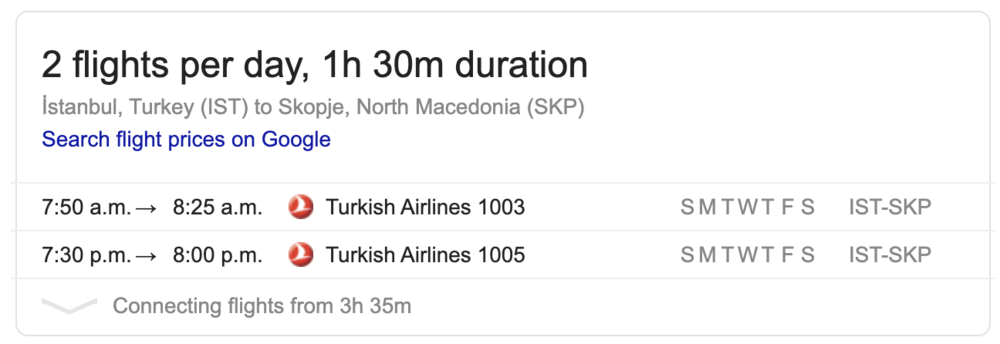
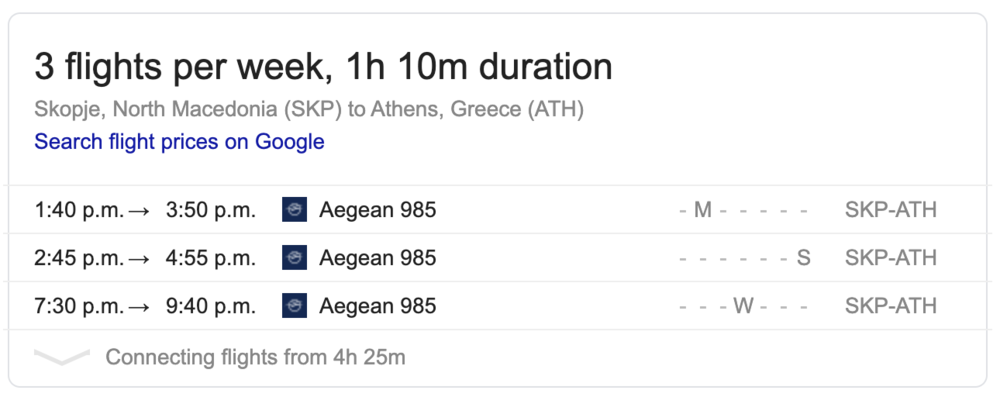
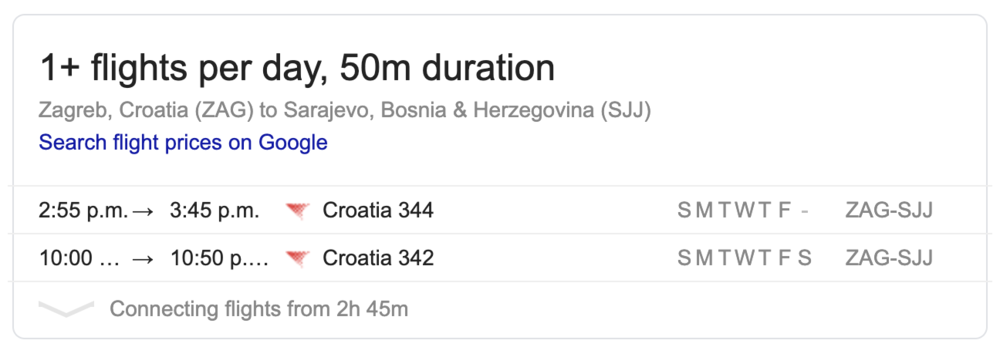
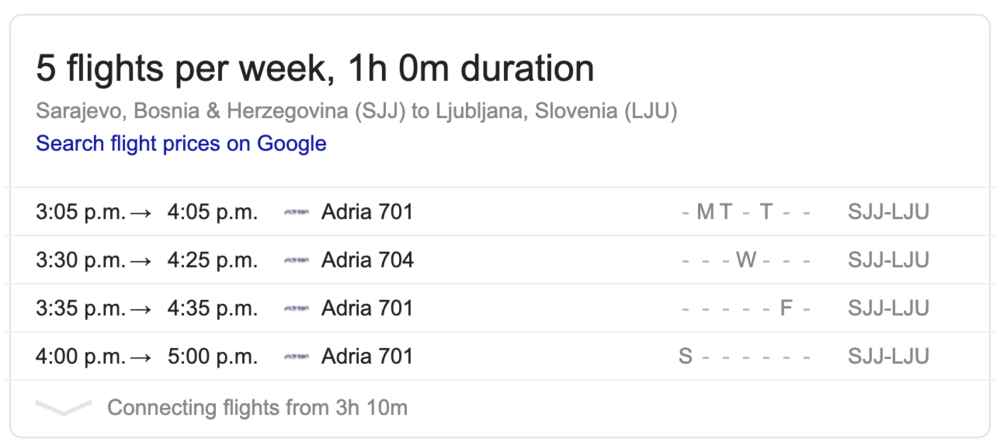
Then, looking at these flight schedules side-by-side, I was able to identify potential connections that fell within 24 hours of each other, such as an 8pm arrival into Skopje followed by a 3:45pm departure the next day, or a 4pm arrival into Sarajevo followed by a 3:30pm departure the next day.
It was also important at this stage to take a quick look at award availability patterns on Aeroplan. After all, there’s no use in adding a certain flight to the agenda if there’s never any award space on it.
I took a quick gander at the search engine, and it turned out that Turkish, Croatia, Adria, and Swiss all had excellent availability, but there was almost no award space on Aegean Airlines flights for next summer. So I briefly went back to the drawing board to strike out the Aegean Airlines flights, planning the journey solely around the remaining airlines.
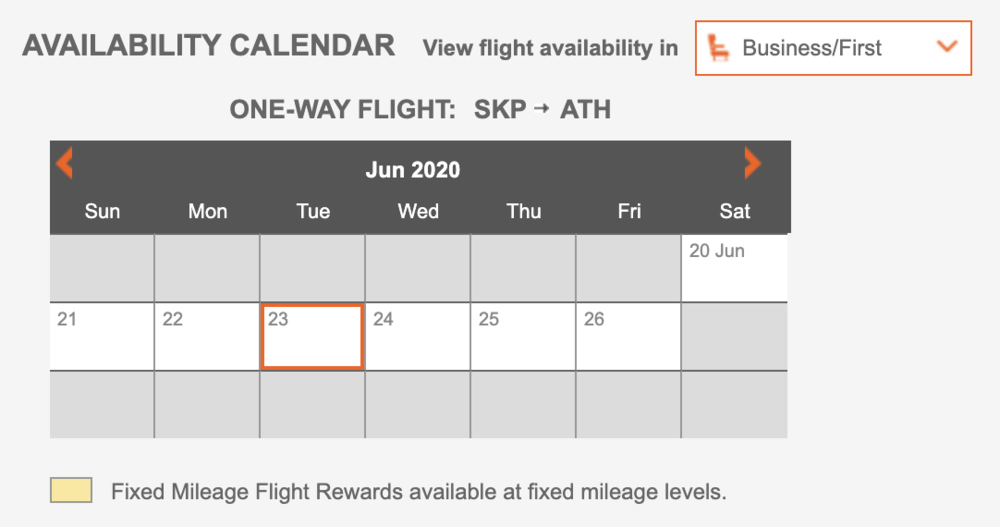
The dearth of Aegean award space also meant that I had to give up some of the Balkan cities on my list. In the end, I settled on an itinerary with long layovers in Skopje, Zagreb, Sarajevo, as well as a little detour up to Prague before heading west towards Spain (the Zurich–Bilbao flight showed no award space, so I just decided to fly to Madrid and take the train instead).
Award availability had been located, and we were looking good:
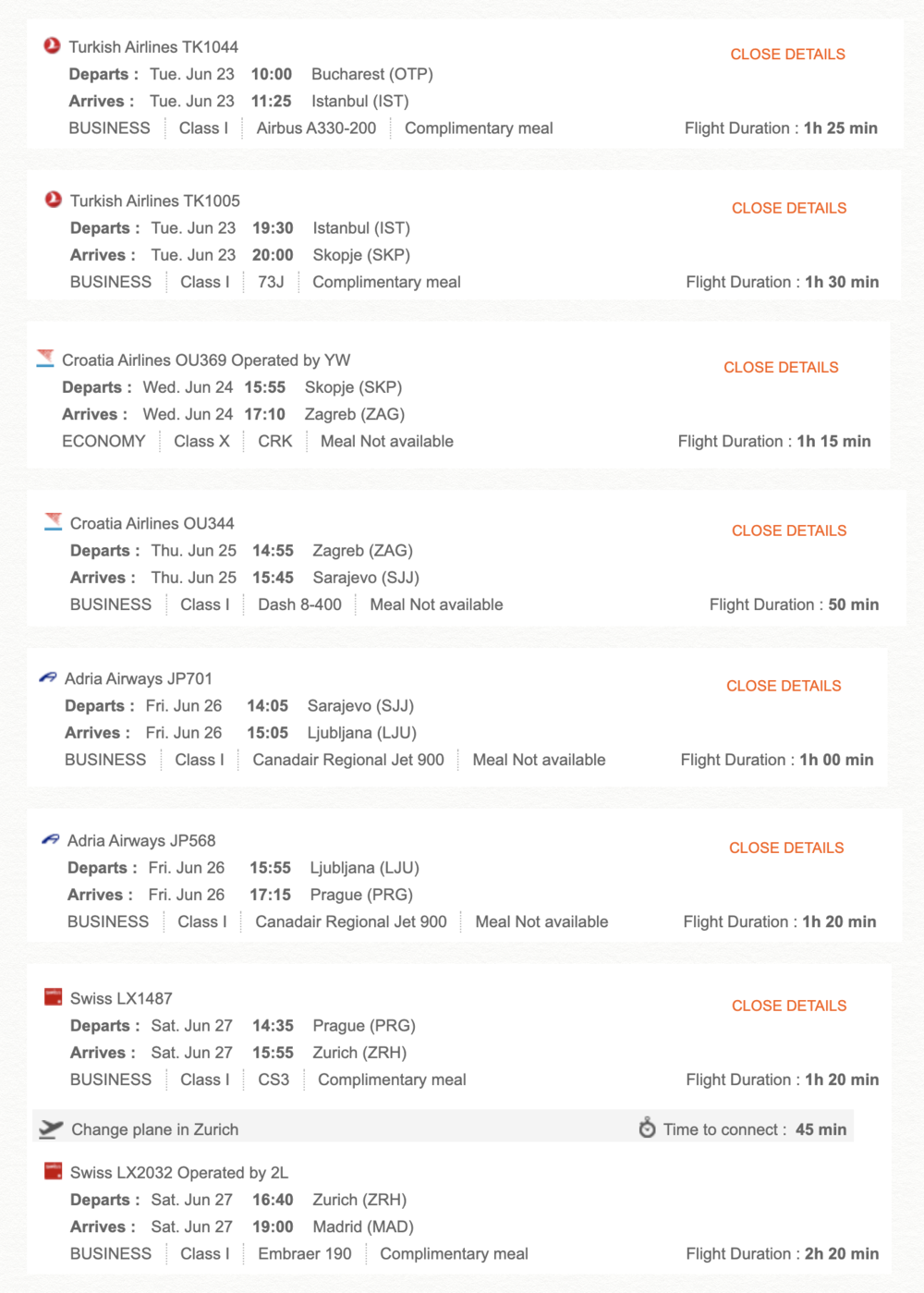
Getting Around the MPM
There was just one problem, though. The MPM between Bucharest and Madrid was only in the range of 2,400 miles, and my routing was well over:

(By the way, if you’re trying to find the MPM between two points in the same continent that’s outside of North America, you can’t use the multi-city trick to locate the MPM, because you’re not allowed to make multi-city bookings that are entirely within the same continent. The only way to figure out the MPM in these cases is to call Aeroplan and ask, which is what I had to do.)
At this point, if someone had made it this far but didn’t grasp the useful hidden tricks of Aeroplan, they might give up in frustration and decide to simply book a more reasonable flight between Romania and Spain instead.
But you guys know how I operate. I immediately set out to see if there were any tricks I could leverage to make my itinerary valid.
And you know what? The geographic definition of Europe is actually pretty large if you think about it, with the westernmost point being Ponta Delgada in Portugal’s Azores islands, a full 1,000 miles further west from Bucharest than Madrid.
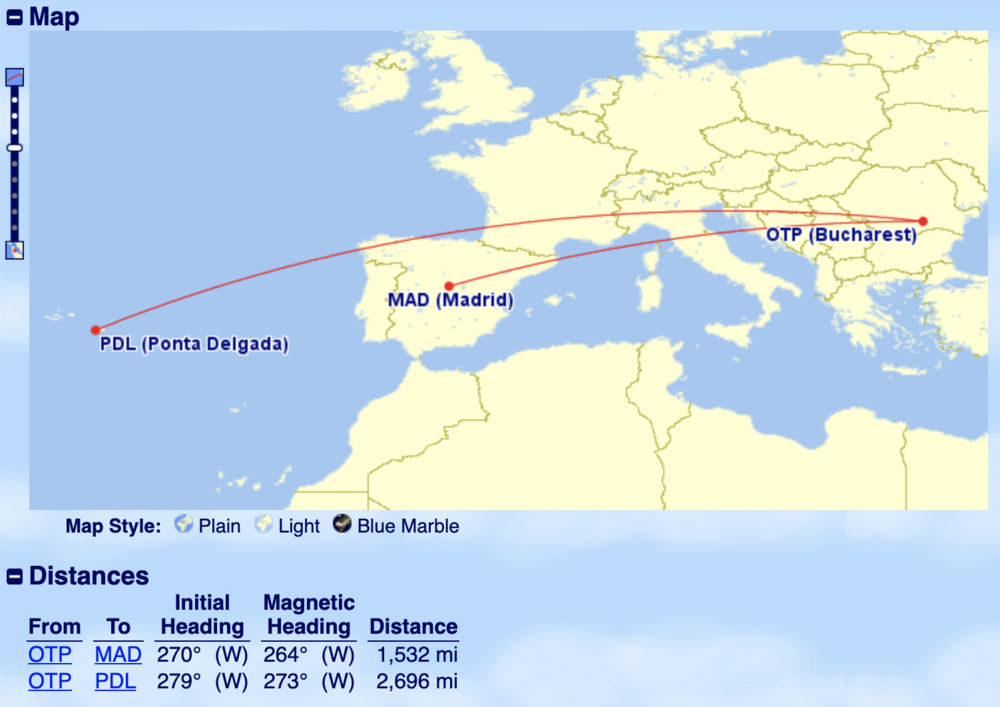
I called Aeroplan to find the MPM between Bucharest and Ponta Delgada, and it turned out to be a much more generous 4,339 miles. Tacking on a few flights to Ponta Delgada after my “true” endpoint of Madrid, and my itinerary was suddenly valid!
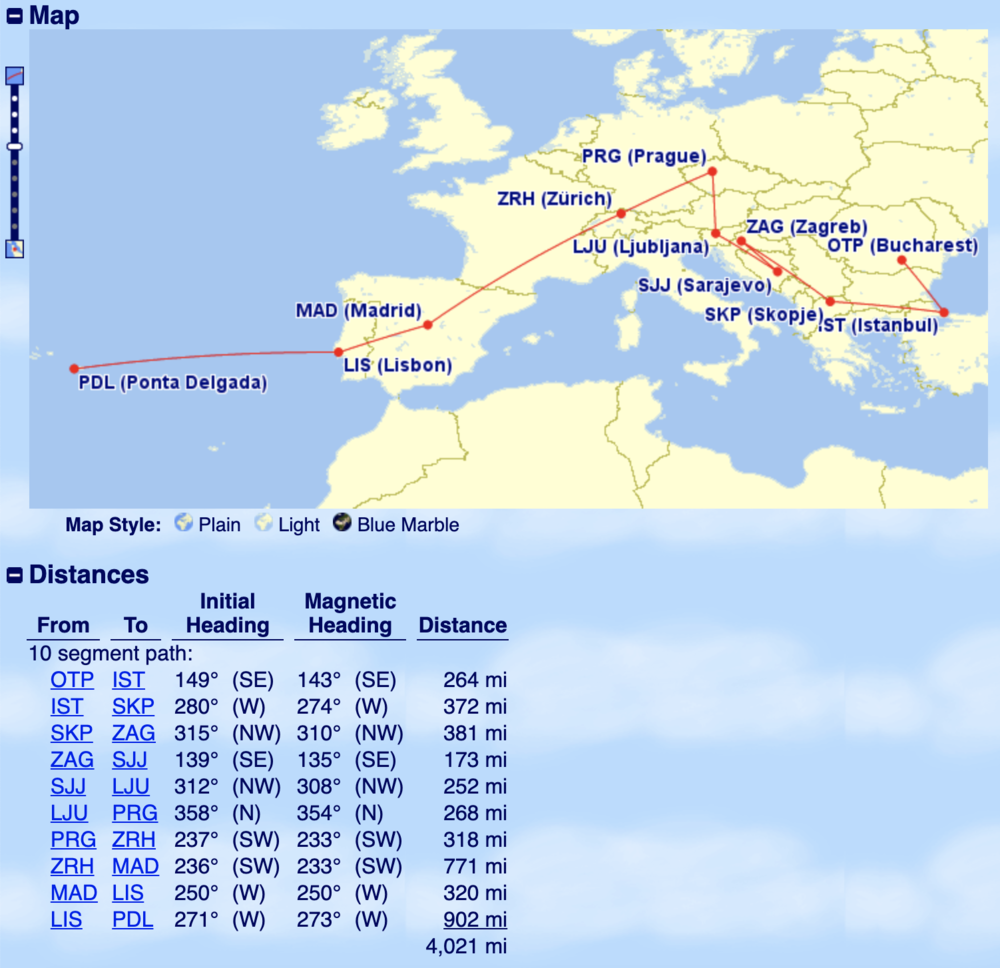
(Of course, I made sure to schedule the TAP Air Portugal flights for the day after my arrival from Madrid, so that it’d be a simple case of me “missing the train to the airport” instead of “having taken the train to San Sebastián instead the previous night”.)
This trick of “extending” your itinerary to a destination to bypass MPM has come in very handy for me on several occasions. It only comes into play on one-way redemptions and when there are in fact further-away destinations within the same region that you can route towards, but it’s so satisfying when it all works out.
Calling Aeroplan to Book
I know Aeroplan has been dealing with massive IT problems recently, with Air Canada implementing new booking systems and a new website as well, but even then I was surprised that I had to wait on hold for 40 minutes before being put through to an agent.
After giving the agent the details of my itinerary, she was initially adamant that it wouldn’t be valid, simply because… I mean, just look at it on the map, it looks absolutely wild.

Bilbao, Spain
I gently reminded her that all the connections were within 24 hours of each other, and that the total distance travelled should very much be within the MPM for Bucharest–Ponta Delgada. At my behest, she was willing to try validating it in the system, and then… just like all the other crazy itineraries I’ve booked over the years, she returned with a nonchalant “oh, can’t believe that worked”.
It was 30,000 Aeroplan miles for a one-way within Europe in business class, and the taxes and fees came out to $290, mainly thanks to Adria Airways’s pesky fuel surcharges of $60 per segment, as well as the fact that there were so many countries’ airport taxes and departure fees on the ticket. Nevertheless, it was a price I was happy to pay for what I’m sure will be a memorable travel experience over the span of six days across Europe.
As usual with these types of itineraries, the Air Canada website simply couldn’t handle it!

Conclusion
One of the more niche redemptions using your Aeroplan miles is building “hopper” journeys using the vast Star Alliance route network, and the Balkans is just one of the many locales where you can play around with the possibilities.
I’m looking forward to maximizing my long layovers in the North Macedonian and Bosnian capitals of Skopje and Sarajevo (both cities that I know almost nothing about going in); revisiting Zagreb, which left a very good impression on me back when I spent a week in Croatia in 2015; and finally getting to see some of Prague, which I have yet to visit for far too long – all in the midst of soaking in the football festivities all across Europe for Euro 2020.




















Now, you just have to hope that none of the flights get cancelled or rescheduled to mess everything up!
Hi Ricky,
Nice blog post. Out of curiosity, why did you decide to spend more Aeroplan miles to fly basically the same economy class seat for short hops around Europe? My gut feeling is telling me that Aegean economy class award seats are much more readily available vs biz class. In that sense you might be able to visit Sofia and/or Tirana which were on your original list of cities you’d like to check out. Also, if you were to fly all the way to the Azores, it’ll be interesting to see how long the luggage tag is going to read if you’re checking a luggage from OTP to Ponta Delgada! That’ll surely be Instagram worthy!
The way I look at it, even though the seat is going to be virtually the same, the added personal space, slightly better service, and more seamless airport experience (for example the dedicated airport bus for business class passengers when you disembark at a remote stand) would be easily worth the extra 15,000 Aeroplan miles over the course of six days. As for checking bags, that’s just asking for trouble somewhere along the way! 🙂
Let me first start off my acknowledging this is an impressive example of optimizing routing rules of a FF program and maximizing points redemption value. But let’s be honest, itineraries like this don’t allow a traveler sufficient time to actually experience anything meaningful in terms of the culture and history of a city and are extremely tiring and potentially stressful due to the constant commuting between airports and hotels, checking in and out of both, packing up belongings, ensuring one doesn’t miss a connection, etc. Personally, I have flown to and from many of these European cities for between $10-$50 on ULCCs like Wizzair, EasyJet, and Ryanair with itineraries that allow several days in between. The hard product on Business class flights within Europe are basically no different than Economy (minus the blocked middle seat) and most lounges can be accessed with Priority Pass and star alliance gold status. Anyways, apologies if I’m sounding a bit negative but I just don’t see how such an itinerary can be enjoyable, especially if you’re traveling with a significant other. Just think of all the conflicts and fights you many have seen watching old episodes of The Amazing Race.
Dude, you’re absolutely right. I couldn’t hope to fully absorb and understand any of these places in the span of one day. But when it comes to my travel style, variety is truly the spice of life, and I figured that getting to see these places for one sunset and one sunrise was better than not getting to see them at all – especially if I can do so without having to sit through Wizz Air flights. As for the stress and fatigue, well, that’s all part of the journey – if you’ve been following my travels you’ll know that I get almost as much pleasure out of the sense of "being on the move" as being on the ground itself.
This type of trip definitely isn’t for everyone. For example, my girlfriend Jessy would loathe every second of it, which is why I only do "hoppers" when I’m travelling on my own.
Hey Ricky,
What are the risks of dropping the last flight? I have the same thing in a mRTW (last flight dropped), however, I have another flight booked out of the same airport on a different airline to a different destination.
In my opinion, there truly aren’t many risks, as long as you aren’t doing this every week or something.
In theory you could get rerouted to your "final" destination by the airline in the case of IRROPs, but scheduling the throwaway leg for the next day should around that.
Great post! You should do one on doing a “South pacific hopper” on Aeroplan (or/and Avios) if such a thing is feasible!
Amazing journey…..but don’t you have another 1,222 miles of available travel remaining ? Maybe take in a few more EURO 2020 games or is there a segment limit for one way travel ? Looks like a myriad of lounge sampling is in order as well. Google flights map also works very well for trip planning. Select departure city, the airline alliance and number of stops from options, then select a destination to see flights/times. Well done. Looking forward to the reports.
Enjoy.
I’ve got about 300 miles to spare until I hit the OTP-PDL MPM, so not a lot of wiggle room left. Definitely looking forward to the lounge-hopping, although I can’t say many of the lounges in the region are likely to blow me away!
I love it when Ricky plans a trip like this. On the surface, it seems simple.
Bucharest to Bilbao, check out a couple of soccer games. Then he manages to extend it into a major European trip. Still pretty cheap and business class to boot. However, he sees a great part of Europe, places us regular people might not get to without the push of seeing something different from this blog even though, from many comments, there seems to be a lot of readers who do travel this way. More power to you!
I am looking forward to the next installment.
We still do not know how he gets to Europe, how he gets to St Petersburg or how he gets home. Great!
And…..he’s done it yet agian 🙂